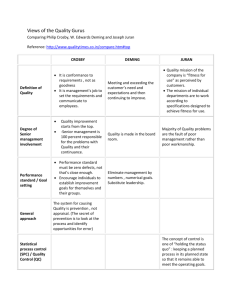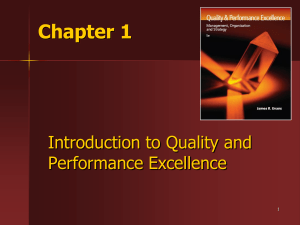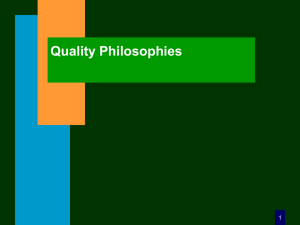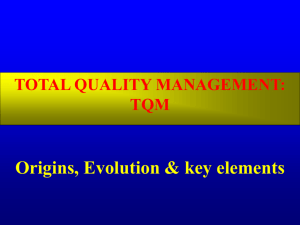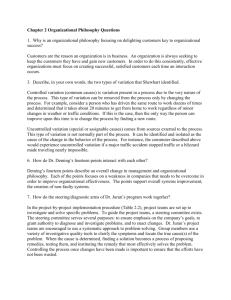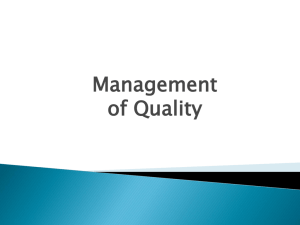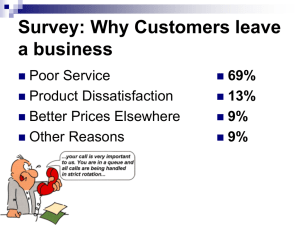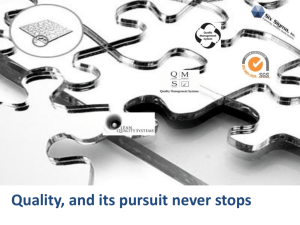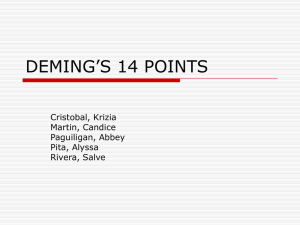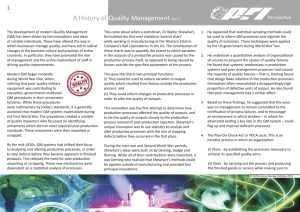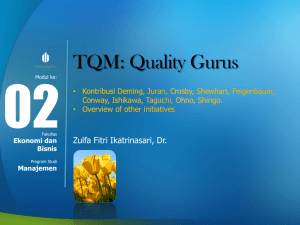Chapter 3
advertisement
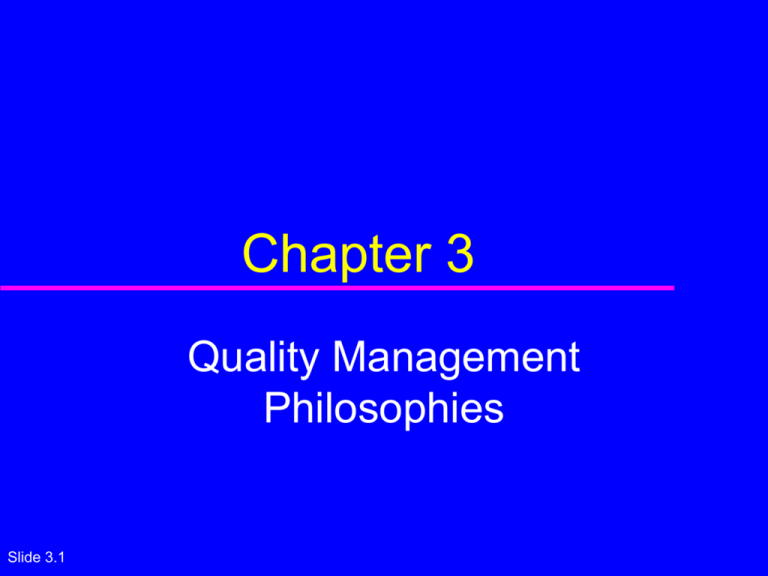
Chapter 3 Quality Management Philosophies Slide 3.1 Leaders in the Quality Revolution u u u Slide 3.2 W. Edwards Deming Joseph M. Juran Philip B. Crosby W. Edward Deming u u u u u u Slide 3.3 Received a Ph.D. in physics and trained as a statistician Worked for Western Electric in the 1920s and 30s After World War II helped Japan implement his statistical quality control Deming became known in 1980 when the broadcast program entitled If Japan Can…Why Can’t We? Credited with having the greatest influence on quality management Quality philosophy focused on reducing uncertainty and variability W. Edward Deming cont… Deming: u u u u Slide 3.4 stressed that the ultimate responsibility for quality improvement lies with top management estimated that 85 to 95 % of variation results from the system maintained that the majority of poor quality in a system is caused by management claimed that higher levels of quality lead to higher levels of productivity Deming Chain Reaction Improve quality Costs decrease because of less rework and mistakes Productivity improves Capture market with better quality and lower price Stay in business and provide more jobs Slide 3.5 Deming’s System of Profound Knowledge u u u u Slide 3.6 Appreciation for a system Understanding variation Theory of knowledge Psychology Systems A system is a set of functions or activities within an organization that work together for the aim of the organization. u u u Components must work together Management must optimize the system Every system must have a purpose Slide 3.7 Variation u u u u Slide 3.8 Many sources of uncontrollable variation exist (common causes) Special (assignable) causes of variation can be recognized and controlled Failure to understand these differences can increase variation in a system Taguchi philosophy seeks to minimize variation around a target value Sources of Variation in Production Processes Materials INPUTS Operators Measurement Instruments Methods PROCESS OUTPUTS Tools Machines Slide 3.9 Environment Human Inspection Performance Traditional View of Conformance to Specifications Loss No Loss 0.480 0.500 Tolerance Slide 3.10 Loss 0.520 Theory of Knowledge u u u Slide 3.11 Knowledge is not possible without theory Experience alone does not establish a theory, it only describes Theory shows a cause and effect relationship that can be used for prediction Psychology u u u u u Slide 3.12 Sincere trust and belief in people Understanding of how people work in systems People are motivated intrinsically and extrinsically; intrinsic motivation is the most powerful Fear is demotivating Managers should develop pride and joy in work Deming’s 14 Points (Abridged) (1 of 2) 1. Create and publish a company mission statement and commit to it. 2. Learn the new philosophy. - Customer driven continuous improvement 3. Understand the purpose of inspection. - workers must be responsible for their work 4. End business practices driven by price alone. - Price has no meaning without quality 5. Constantly improve system of production and service. 6. Institute training. - Job specific training Slide 3.13 Deming’s 14 Points (2 of 2) 7. Teach and institute leadership. 8. Drive out fear and create trust. 9. Optimize team and individual efforts. 10. Eliminate exhortations for work force. 11. Eliminate numerical quotas and M.B.O. Focus on improvement. 12. Remove barriers that rob people of pride of workmanship. 13. Encourage education and self-improvement. 14. Take action to accomplish the transformation. Slide 3.14 Deming Prize u u u Instituted 1951 by Union of Japanese Scientists and Engineers (JUSE) in Japan Several categories including prizes for individuals, factories, small companies, and Deming application prize American company winners – Florida Power & Light (first U.S. winner) Slide 3.15 Joseph Juran u u u u u Slide 3.16 Industrial Engineer Joined Western Electric in the 1920s Authored The Quality Control Handbook which often referred to as the quality bible Believed quality improvement should be achieved through projects Focused on three major quality processes, called the Quality Trilogy Juran’s Quality Trilogy u Quality planning – Preparing to meet quality goals u Quality control – Meeting quality goals during operations u Q.P Quality improvement – Reaching unprecedented levels of performance Slide 3.17 Q.C. Q.I. Key Idea u u Slide 3.18 Juran proposed a simple definition of quality: “fitness for use.” This definition of quality suggests that it should be viewed from both external and internal perspectives; that is, quality is related to “(1) product performance that results in customer satisfaction; (2) freedom from product deficiencies, which avoids customer dissatisfaction.” Philip B. Crosby u u u u Corporate V.P. for quality at International Telephone Authored book entitled Quality is Free Believed that zero defects is a realistic goal Defined the cost of quality as: – Expense of nonconformance Slide 3.19 Phillip B. Crosby Quality is free . . . u “Quality is free. It’s not a gift, but it is free. What costs money are the unquality things -all the actions that involve not doing jobs right the first time.” Philip B. Crosby’s Philosophy Absolutes of Quality Management: u quality means conformance to requirements – Requirements must be clearly stated so they can’t be misunderstood u problems are functional in nature – Problems must be identified by those individuals that cause them Slide 3.20 Philip B. Crosby’s Philosophy cont… u there is no optimum level of defects – Doing the job right the first time is always cheaper u cost of quality is the only useful measurement – Quality cost data are useful to call problems to management’s attention – Crosby estimated that most companies spend 15 to 20 percent of their sales dollars on quality costs u Slide 3.21 zero defects is the only performance standard
